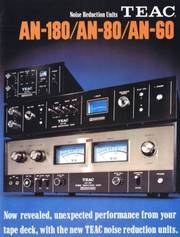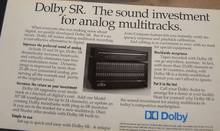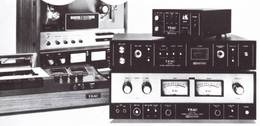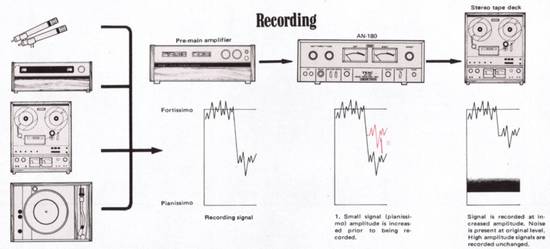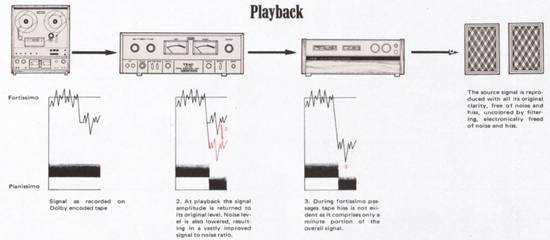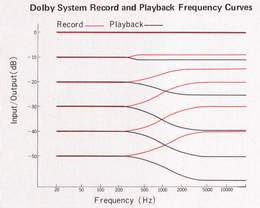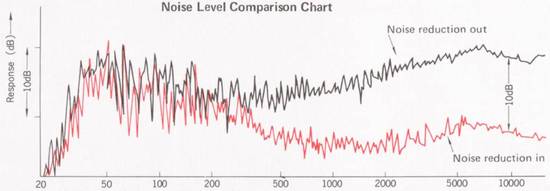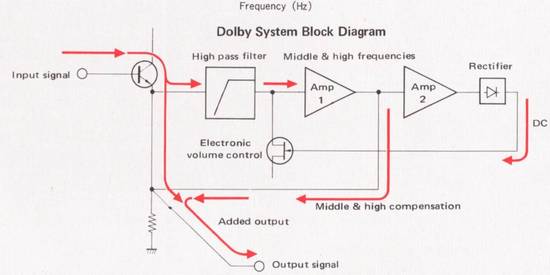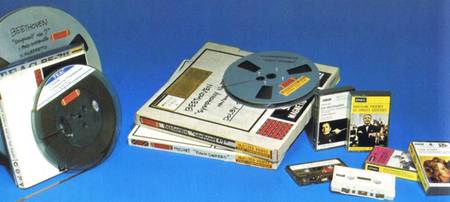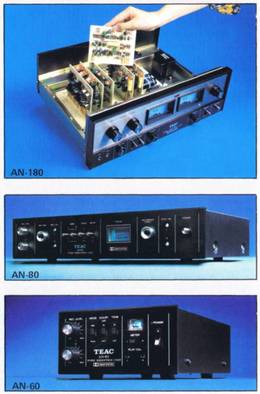TEAC war der erste Hersteller, der DOLBY richtig vorantrieb
Meines Wissens gab es im Consumer-Bereich bereits vor 1971 erste DOLBY- Vorsatzgeräte, die zwischen die Mikrofone / Mischpulte und Bandgeräte geschaltet wurden und danach wieder an das Bandgerät hinten dran zum Verstärker gekoppelt wurden. Die kosteten vergleichbar eine Menge Geld und sahen nicht nur komisch aus, sie hatten auch keinen optischen "Glaubwürdigeits- Bonus" - für so viel Geld.
Dann kam TEAC mit tollen bunten Prospekten und da gab es (in Wiesbaden) diesen amerikanischen "Audio-Club", in dem die Amerikaner soetwas kaufen konnten. Meine Freunde hatten solch einen TEAC AN180 für einen Bruchteil des deutschen Preises gekauft und dazu ein riesiges PIONEER Bandgerät. Das war leider nicht berauschend, sollte doch dieses DOLBY-Teil das Rauschen gewaltig unterdrücken.
Das PIONEER Bandgerät verschwand irgendwann rüber in die USA und das TEAC AN180 "flüchtete" zu mir. Jetzt durfte ich (endlich) mal rein schaun. Oh weh, war das enttäuschend, das Ding war ja nahezu leer. Schon der kleine Trafo stand mutterseelenalleine in dem riesigen Kasten
Also verglichen mit der tollen Optik war es für uns eine mittlere Katastrophe, so wenig Technik für so viel Geld anzubieten. Darum schaun wir erst mal auf den englischen (US-) Farb- Prospekt.
DOLBY A oder B oder C ?? Kein Wort davon.
In dem ganzen Prospekt steht (natürlich) kein Wort davon, daß es damals bereits mehrere Varianten dieses Rauschunterdrückungssystems vom System DOLBY gab. Das sollten die Hobbyisten gar nicht wissen. Das hätte sie nur verwirrt.
Die Profis hatten einen DOLBY Compander/Expander für etwa 20.000.- Dollar. Damit ließ sich edle Stereo-Studio- Qualität realisieren. Dieses 19" Profi-Gerät war aber fast so groß wie die großen TEAC Bandmaschinen.
In den AES Vorträgen (AES = die amerikanische "Tonmeister- Vereinigung") wurde die aufwendige Funktion des Studio-DOLBY- Systems ausführlich vorgetragen und analysiert. Das war natürlich "edle Sahne", doch das alles wußten wir damals noch nicht.
Kurzzusammenfassung (analoges Dolby):
Wir reden hier nur von dem analogen Rauschunterdrückungsverfahren :
DOLBY (oder DOLBY A) = 1966 - Aufteilung auf 4 Frequenzbänder
DOLBY B = 1968 (auch DOLBY "NR") - nur 1 Frequenzband - dynamische Frequenzgrenze
DOLBY C = 1980 arbeitet mit 2 kaskadierten Kompressoren
DOLBY SR = 1987 (Nachfolger von DOLBY A aber nur für den Lichttonfilm)
DOLBY S = 1990 (Nachfolger von DOLBY SR) = nur 3 Frequenzbänder
.
und dann kamen die digitalen Dolby-Varianten mit vielen Kanälen
.
Discover Unexpected Performance from Your Present Tape Deck with The New TEAC Noise reduction Units.
.
Das ist die pauschale Aussage dieses 6-seitigen Prospektes, den wir so um 1971 aufgrund der super gemachten Fotos auf der Frontseite beinahe verschlungen hatten. Das muß also der Stein der Weisen sein. Endlich Studio-Qualität zum Lowcost-Preis - und das selbst für die schlimmsten Tonbandgurken, die es zu kaufen gab. Daß das alle nur Wunschdenken der Werbetexter war, konnten und wollten wir damals gar nicht verifizieren. Die ersten Tests - natürlich mit einer Revox A77 Halbspur, die ja sowieso schon sehr gut war, waren super und glaubwürdig. Das Ergebnis aber auf ein recht primitves Grundig TK14 oder ein qualitativ ähnliches Billig-Kassenttendeck herunter zu rechnen, war natürlich völliger Humbug. Doch damals gingen die Uhren anders als Heute.
.
The TEAC noise reduction units may be used with any good quality tape deck, open reel or cassette.
Their prime purpose is the elimination of inherent tape and recorder noise and hiss while recording magnetic tapes. Noise free recording is thus possible from a variety of sources such as FM broadcasts, discs or when copying from another tape deck.
Due to the expansion/compression principles employed in this process the Noise Reduction Unit should be in use for both recording and playback functions. Once a tape has been Dolby encoded (recorded through the Dolby circuitry) it should be reproduced through the Dolby circuitry in order to enjoy optimum results. This should not be construed to mean that Dolby encoded tapes cannot be played on a non-Dolby unit. They can, however some tone compensation will be required as Dolby encoded tapes played back on a conventional recorder will have a somewhat brighter than normal sound.
.
The Dolby System is not a hi-cut filter.
Other so-called noise reduction systems operate by filtering out a portion of the high frequency spectrum during playback, some loss of the audio spectrum is thus inevitable. The Dolby principle is to reduce the noise amplitude in relation to the desired signal strength, thus there is no filtering action through the circuit used for the recording/playback process. The original program material is reproduced unchanged, only the noise and hiss are effected.
The Dolby System will not eliminate noise present in the original program source, it does reduce or completely eliminate the inherent tape hiss and any noises normally added during the recording or dubbing process.
Die Aufnahme mit DOLBY
.
The TEAC noise reduction units are designed for versatility and broad applicability.
They may be used with virtually any tape recorder. They may be easily connected to your existing audio center. No complicated wiring or operating skill is required. Remarkably easy to operate, only a simple calibration is required upon initial installation.
The TEAC GSL (Superior Sound/Low Noise) tape decks incorporate many features designed to fully utilize low noise tapes, features such as dual level bias, expanded scale VU meters, meter level switches, high density ferrite heads and low noise preamplifiers. These decks in combination with a TEAC noise reduction unit will provide the ultimate in low noise, stereo home tape recording.
The TEAC noise reduction units will materially improve the quality and performance of any tape.
There are no restrictions on the type of tape that may be used. The Dolby process is equally effective with conventional, chromium dioxide, low noise/high output or high energy tape.
.
Dramatically improves cassette performance.
Several design factors such as slow tape speed, closely spaced narrow tracks and an extremely thin oxide coating have made noise and hiss a major problem in cassette recordings. It is here that the most dramatic improvement will be noted. For the first time, true open reel quality can be obtained with a cassette recorder.
- Anmerkung : Das ist natürlich genau der Unsinn, auf den so viele reingefallen waren. Selbst mit DOLBY - egal ewelche Variante - hatte man auch mit den teuersten Cassettenrecordern nie die "open-reel" Qualität. Das schmale Band mit den schmalen Spuren und der niedrigen Geschwindigkeit gab es ja gar nicht her.
Also many prerecorded cassettes are now being Dolby encoded. In fact some major recording companies such as London Records and CBS are producing only Dolby encoded cassettes. As a result overall cassette quality has increased and the prices to the consumer are being reduced. Even though you may record infrequently you will enjoy the benefits of the Dolby System during playback of prerecorded Dolby encoded tapes.
.
Die Wiedergabe mit DOLBY
.
The TEAC noise reduction units will dramatically improve the performance of even semi-professional or professional machines.
A significant improvement in signal to noise ratio is readily apparent even on 2 track machines operating at 15 ips. You cannot actually realize the full potential of your tape deck until you have experienced the 10dB improvement in signal to noise ratio and the widened dynamic range made possible by these noise reduction units. We are confident that once you have tried this process you will never again be satisfied with the conventional recording methods.
Numerous FM broadcasting stations are now transmitting Dolby encoded FM programs on an experimental basis.
The improvement in sound quality is dramatic and results have been most promising. It is anticipated that this broadcasting method will become increasingly popular in the immediate future. The TEAC noise reduction units when connected between your tuner and amplifier will provide reception of Dolby encoded FM broadcasts completely free of matrix or multiplex carrier noise.
- Anmerkung : In Europa gab es meines Wissens nach nie einen Sender, der über egal welchen Wellenbereich ein mit DOLBY codiertes Porgramm ausgestrahlt hatte.
.
The TEAC noise reduction units make possible the dubbing of tapes without cumulative noise buildup.
Normally as a tape is copied, the noise level tends to double. The inherent noise or hiss of the original tape is transferred to and added with the noise of the tape being made. Noise buildup was the end result. With the TEAC noise reduction unit this noise buildup no longer occurs. You may copy a tape as often as desired without serious degradation of the original high sound quality.
.
A major benefit derived from this system is the tape economy.
You may now produce recordings at reduced tape speeds without loss of audio quality. Your noise reduction unit will actually pay for itself through reduced raw tape costs.
The Dolby Noise Reduction System
The Dolby process basically increases the amplitude of low level signals prior to their being recorded and decreases their amplitude by precisely the same amount (by use of a mirror image circuit) during playback. During this process all inherent tape hiss and noises added by the recorder are eliminated or reduced to an inaudible level. At low signal levels where noise is most apparent, boosting is maximum, as signal levels rise, boosting is reduced. Overall signal to noise ratio is vastly improved, and the original signal is reproduced completely free of coloration, noise and tape hiss. The Dolby System provides a SN ratio increase of 3dB at 600Hz, rising to 5dB at 1,000Hz and 10dB at 4kHz and above.
.
Der Vergleich beim Rauschen
Die Regelfunktion der Pegelanhebung
.
NEW PERFORMANCE LEVELS with a TEAC noise reduction unit.
Upgrade the performance of your present tape deck, find out how good it really can be.
A major problem in home tape recording has been the noise and hiss inherent in the tape itself and that added during the recording process. The elimination of this annoyance has been the objective of much research since the advent of magnetic recording. We of TEAC are pleased to introduce the production of a series of noise reduction units designed to eliminate this annoyance and enable you to produce recordings of a quality heretofore impossible.
Many kinds of noise exist to plague the serious music lover but the most apparent and persistent type has been the tape hiss formerly considered an inevitable factor in magnetic recording. It was particularly evident during pianissimo or low level passages and was always present even on recordings made with the best available tape on the most sophisticated equipment. This hiss tended to increase as tape speeds were lowered and track width and spacing were narrowed. This hiss also tended to add as tapes were copied or dubbed.
Now through modern scientific technology, the Dolby Noise Reduction System totally eliminates tape noise and hiss as a limiting factor in the production of quality recordings.
This system permits the recording and reproduction of delicate pianissimo passages formerly covered or masked by tape noise and hiss. When added to your present equipment, it makes available a wider dynamic sound range, a new clarity and brilliance with a complete absence of attenuative filtering. Low level passages are reproduced in all their original beauty, tonal nuances formerly covered by the noise mask will be heard for the first time. Not only will you experience superior sound, your tape expenses can be halved as you may record at reduced tape speed without sacrificing sound quality.
The Dolby Noise Reduction System has won wide acceptance within the recording industry and is used for the production of master recordings by virtually all recording companies. Now with the introduction of these superb noise reduction units, the myriad benefits of this system are available to the tape hobbyist at a sharply reduced cost.
As we at TEAC manufacture our own ICs (integrated circuits) under an extremely rigid quality control program and assemble the Dolby circuitry to very close electronic tolerances. We have succeeded in reducing distortion levels over competing units using the Dolby System by as much as 3%.
All controls have been "human engineered" for optimum ease of operation. Calibration procedures have been simplified and reduced to a minimum. Once properly accomplished they normally need not be recalibrated unless system components are changed.
Stop in today at your TEAC showroom and audition these revolutionary units. Discover the unused potential in your tape deck, see for yourself the dramatic improvement in sound quality now available, with the TEAC noise reduction units.
Noise Reduction Units TEAC AN-180/AN-80/AN-60
.
- AN-180
Functions as a simultaneous record /playback control center.
Separate record and playback Dolby circuitry.
Independent microphone and line input level controls.
Adds mic/line mixing feature to those systems not having this facility.
Two large professional VU meters provide accurate Dolby calibration and replace the tape decks' meters for more accurate signal monitoring.
Complete calibration controls provide compatibility with virtually any recorder.
Internal test tone oscillator.
Individual output controls.
Source/tape monitor switch for instant signal comparison.
Sophisticated multiplex filter eliminates pilot tone or carrier interference when recording from FM broadcasts. - AN-80 is a less complex moderate cost version of the AN-180. It provides the same noise reduction characteristics with somewhat lessened convenience.
Input mixing has been omitted and one Dolby circuit has been provided per channel rather than two. As in the professional "A" system the same card functions for recording or playback but not at the same time. The result is performance identical to that of the more elaborate unit but at minimum expense. - AN-60 is a companion Dolby unit for open reel or cassette decks. Compact, simple to operate and inexpensive, yet it provides all the benefits of the more complex and costly unit. Simplicity of operation is the keynote of this unit. Simply connect it between your recording source and tape or cassette recorder. The AN-60 goes to work with the flick of a switch, reducing tape hiss and noise to levels below audibility. Discover a new dimension in sound with this all new, compact noise reduction unit.
.
SPECIFICATIONS
| AN-180 | AN-80 | AN-60 | |
|---|---|---|---|
| Frequency Response | 20 -20,000 Hz ±1.5dB (MPX FILTER OUT) 20 -15,000 Hz ±1.5dB (MPX FILTER IN) | 20- 15,000 Hz ±2dB | 20- 15,000 Hz ±2dB |
| Increased | 10dB at 10,000 Hz | 10dB at 10,000 Hz | 10dB at 10,000 Hz |
| SN Ratio | 5dB at 1,000 Hz | 5dB at 1,000 Hz | 5dB at 1,000 Hz |
| better than 6 dB over all | better than 6 dB over all | better than 6 dB over all | |
| ("B"_weighting_network) | ("B"_weighting_network) | ("B"_weighting_network) | |
| Input Sensitivity | Microphone: 0.25mV/-72 dB (600 - 10,000 ohms) | ||
| Line : 0.1 V | Line: 0.03 V | Line: 0.1 V | |
| Input Impedance | Microphone: 50,000 ohms | ||
| Line : 100,000 ohms | Line: 35,000 ohms | Line: 35,000 ohms | |
| Output | To tape deck input: 0.5 V | To tape deck input: 0.58 V | To tape deck input: 0.3 V |
| Line : 1 V | Line : 0.58 V | Line : 0.58 V | |
| Harmonic Distortion | below 0.3% | below 0.5% | below 0.5% |
| Multiplex Filter | better than -35 dB at 19k Hz | better than -35 dB at 19k Hz | better than -30 dB at 19k Hz |
| better than -30 dB at 38k Hz | better than -30 dB at 38k Hz | ||
| Channel Separation | better than 50 dB | better than 50 dB | better than 50 dB |
| Oscillator Output Level | 0.1 V | ||
| Tone Oscillator | 400 Hz | 400 Hz | 400 Hz |
| Power Requirements | 100/117/220/240 V AC, | 100/117/220/240 V AC, | 100/11 7/200/220/240 V AC, |
| 50/60 Hz, 6W | 50/60 Hz, 4 W | 50/60 Hz, 2.5 W | |
| AC Outlet | Unswitched: 500 W max. | Unswitched: 500 W max. | |
| Dimensions | b]A"(H) x 16X"(W) x 12X"(D) | 3K"(H) x 16%"(W)x 10^"(D) | 3%"(H)x6%"(\N) x 10%"(D) |
| [141(H) x 410IW) x 328(D)mm] | [88(H) x 410(W) x 273(D)mm] | [86(H) x 160(W) x 268(D)mm] | |
| Weight | 15K lbs. [7 kg] net | 8% lbs. [4 kg] net | 4% lbs. [2 kg] net |
| Standard Accessories | Test tape (Open reel) | Test tape (Open reel) | Test tape (Open reel) |
| Test tape (Cassette) | Test tape (Cassette) | Test tape (Cassette) |
.
Es war einmal
TEAC CORPORATION SALES OFFICE: SHINJUKU BLDG., 1-8-1, NISHI-SHINJUKU, TOKYO PHONE: (03) 343-5151
TEAC CORPORATION OF AMERICA 7733 TELEGRAPH ROAD, MONTEBELLO, CALIFORNIA 90640 PHONE: (213) 726-0303
TEAC EUROPE B.V. KABELWEG 45-47, AMSTERDAM-W. 2 NETHERLANDS PHONE: 020-821656
TEAC HONGKONG LIMITED ROOM No. 1105 MELBOURNE PLAZA 33 QUEEN'S ROAD C. HONG KONG PHONE: 252027
.

